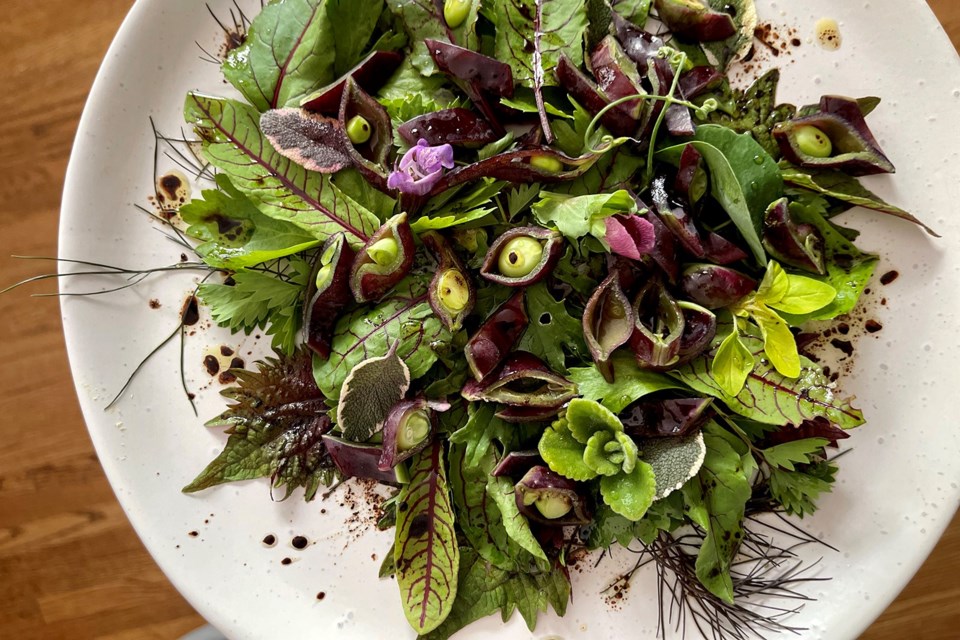Yesterday, during my early morning garden walk-about – those thirty minutes spent outdoors without sunscreen, sunglasses, sunhat or other filters – to harvest unadulterated Vitamin D, I was overwhelmed by purple.
Deep shades of amethyst, violet, crushed velvet, crimson and royal purple, made fresh by dew, and framed by bright and translucent shades of green, called from all corners for attention. Morning light, still low and clear, has a way of lighting up the garden from below, like footlights on a stage as the curtain rises.
Purple and green go together on a plate and in one’s diet, so naturally as if by design. The colour purple is potent, powered in the plant world by natural phytopigments called anthocyanins that are credited with lowering inflammation, fighting cancer and heart disease, and improving brain health.
I made an effort this year to lean more heavily on purple, adding piccolo eggplants, purple potatoes, King Tut peas, Indigo Rose tomatoes and Beauregarde snow peas to our garden menu.
Already, perennial purple asparagus, wild evergreen huckleberries, elderberries, damson plums, blueberries and black raspberries offer anthocyanin in rotation throughout the seasons.
The beautiful, open-pollinated and certified organic Beauregarde snow peas from Row 7 Seeds have quite simply taken my breath away. Unlike most purple-podded peas and beans that fade to green when cooked, Beauregard’s were designed by plant breeder Michael Mazourek to retain their vibrant purple jackets and contrasting lime green zippers and pea orbs.
I’ve enjoyed experimenting in the kitchen with Beauregardes by steaming, sautéing, pureeing and roasting them at various stages of development from slim snows to plump, fully developed pea pods, and at no stage have they lost their sweetness or palatability.
Beauregardes’ growth habit and resilience seem ideally suited to our garden and to the vagaries of our changing climate. Unseasonal heat and cold have not wounded or discouraged the vines or the fruit, and for some reason pests (other than veggie dog Dave) seem disinterested. The vines themselves are rather short and stalky, having not yet reached halfway up the trellises.
The stems are Jack and the Beanstalk substantial, and leaf sets are close and abundant. Harvesting takes work, however, as the peas hang on tight to the stalks. Typically, by Canada Day weekend, early peas have died back and pole beans have all but replaced them on the trellises. This year, we are shuffling trays of pole bean babies in and out of cool shade in an attempt to keep them happy but somewhat thwarted, while the Beauregards finish their final(?) flush.
I will plant Beauregards again mid-August so that we might enjoy them when the eggplants, purple potatoes, purple tomatoes and evergreen huckleberries are at their finest.
For now, I am happy to play with the purples and greens that are in season. A drop salad, made by dropping concentric rings of ever smaller vegetable, fruit and herb leaves of various textures and shades of purple and green – “from a height,” as Jamie Oliver would say – one over another onto a cold plate, and then drizzling a non-emulsified dressing of Novello olive oil and aged cherry balsamic overtop, was just the ticket for lunch yesterday.
The salad was as beautiful as it was nutrient-dense and delicious. Without question, bias-cut Beauregarde snow peas were the feature attraction, adding texture and colour, as well as a host of anti-inflammatory, antioxidant goodness including thiamine, folate, manganese, iron, and phosphorus, plus vitamins A, B, K and C.
Beauregarde snow peas are available online through Row 7 Seeds, a company built by chefs, farmers and plant breeders who strive to make ingredients perform and taste better before they even hit the plate.
Laura Marie Neubert is a West Vancouver-based urban permaculture designer. Follow her on Instagram @upfrontandbeautiful, learn more about permaculture by visiting her Upfront & Beautiful website or email your questions to her here.
For a taste of permaculture, watch the video below:




